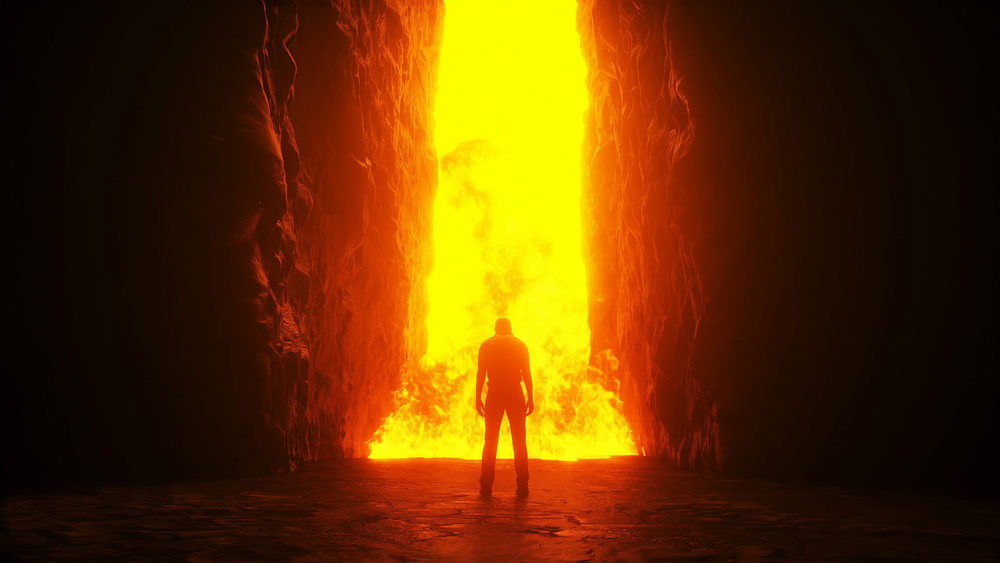Scientists ‘Discover Where the Gates of Hell Is REALLY Located’

Imagine standing at the edge of a smoldering volcano, stepping into a shadowy cave, or walking through a valley whispered about in ancient texts. For centuries, stories of hell’s gates have intrigued and terrified humanity, blending myth, faith, and mystery. Are these places purely metaphorical, or do they exist somewhere on Earth, waiting to be discovered?
From the Valley of Hinnom, where fire and sacrifice once filled the air, to an Icelandic volcano that spewed its wrath into the skies, cultures across the globe have pointed to ominous sites as the underworld’s doorstep. But what happens when science steps in to examine these eerie locations? Could these stories hold more truth than we once thought?
Gehenna – Hell on Earth
 Image source: HolyLandSite on YouTube
Image source: HolyLandSite on YouTube
Tucked outside the ancient walls of Jerusalem lies a valley with a haunting past. Known as the Valley of Hinnom—or Gehenna—this gorge has been the focus of ominous tales for millennia. While the word “Gehenna” might sound unfamiliar, its modern interpretation as “hell” ties directly to its grim history. According to biblical accounts, this valley was once the site of horrific child sacrifices to the god Baal, a practice that left an indelible stain on its legacy.
New Testament scholar Bart Ehrman notes that in ancient times, the ultimate punishment wasn’t fire or torment—it was the denial of a proper burial. By referencing Gehenna in his teachings, Jesus painted a vivid picture of disgrace, suggesting that the wicked would be cast into this cursed valley, denied dignity even in death. Ehrman explains, “Corpses of those excluded from the kingdom would be unceremoniously tossed into the most desecrated dumping ground on the planet.”
Legends surrounding Gehenna’s perpetually burning fires may have inspired its fiery reputation. Some accounts suggest that it served as a landfill, where waste burned continuously, creating an image of eternal flames. Although there’s no solid archaeological evidence of such use, the symbolism of unending fire has endured, shaping modern depictions of hell.
As the Bible was translated and retold, “Gehenna” evolved into the English term “hell,” and the valley’s history intertwined with Christianity’s vision of eternal punishment. Today, the Valley of Hinnom stands as a stark reminder of the ancient fears that birthed our modern understanding of hell—both as a physical place and a spiritual concept.
Hierapolis – The Deadly Portal in Turkey
 Image source: Shutterstock
Image source: Shutterstock
In the heart of modern-day Turkey lies the ancient city of Hierapolis, a marvel of Roman engineering and architecture. Among its grand baths, sprawling gymnasium, and bustling agora, there is a far darker feature: the Plutonium, a gateway believed to lead straight to the underworld. This foreboding site earned its reputation not through myth alone, but through a chilling reality that still mystifies scientists today.
The ancient philosopher Strabo described the Plutonium as a deadly cave filled with a thick, suffocating vapor. He wrote, “[The] space is filled with a cloudy and dark vapour, so dense that the bottom can scarcely be discerned … Animals which enter … die instantly.” Rituals performed at this site involved priests leading animals into the grotto, where they would perish in front of stunned onlookers, seemingly struck down by supernatural forces. Strabo’s chilling account noted even sparrows thrown into the cave would drop lifeless to the ground.
Modern science, however, has unraveled the terrifying secret of this ancient portal. Researchers discovered that the Plutonium sits atop an active volcanic fault line, which emits concentrated clouds of carbon dioxide. During the night, these gases pool near the ground, creating a lethal trap for animals while sparing the taller priests who stood above the vapor.
Even today, the Plutonium retains its eerie power, with toxic gases occasionally seeping from the cave’s depths. While the ancients attributed these deadly fumes to the breath of Kerberos, the mythical three-headed guard dog of Hades, science reveals a natural explanation for this hellish phenomenon. Still, standing near the entrance of Hierapolis’ Plutonium offers an unsettling glimpse into a place where ancient beliefs and geological reality collide.
Hekla – Iceland’s Fiery Inferno
 Image source: Pexels
Image source: Pexels
Rising dramatically against Iceland’s southern skyline, the volcano Hekla has loomed large in both the landscape and the imagination of those who’ve lived under its shadow. Known as one of Iceland’s most active volcanoes, Hekla’s fiery eruptions earned it a sinister reputation during the Middle Ages, when it was believed to be a direct gateway to hell.
The name “Hekla” itself, meaning “hooded cloak,” evokes the image of the dense clouds that often shroud its peak. This ominous appearance, paired with violent eruptions like the one in 1104, left medieval onlookers convinced that this was no ordinary volcano. The 1104 eruption unleashed catastrophic lava flows and ash clouds that blanketed over half of Iceland, spreading tales of destruction far beyond its shores.
Medieval writers painted vivid pictures of the volcano as the prison of the damned. Caspar Peucer, a 16th-century scholar, declared Hekla to be “the bottomless abyss” where souls descended into infernal torment. Some accounts even claimed to witness large, bird-like creatures—thought to be the souls of the damned—diving into the volcanic fires.
In reality, Hekla’s activity is a reminder of the raw, unstoppable power of nature. Since its infamous eruption in 1104, the volcano has erupted roughly 20 times, with its most recent outburst in 2000 creating a fissure nearly seven kilometers long. While science may dispel the idea of Hekla as a gateway to hell, standing near this volcanic giant—its history steeped in both legend and geological ferocity—can still feel like peering into the fiery depths of the Earth itself.
Actun Tunichil Muknal – The Mayan Underworld
 Image source: Shutterstock
Image source: Shutterstock
Deep in the jungles of Belize lies Actun Tunichil Muknal, a cave whose name translates to “Cave of the Stone Sepulcher.” To the ancient Maya, this cavern was no mere geographic feature—it was believed to be a portal to Xibalba, the underworld ruled by death gods. Its winding, dark tunnels tell a harrowing story of ritual sacrifice, fear, and the desperate plea for divine intervention.
Discovered in 1989, the cave stretches over three miles and contains artifacts and skeletal remains dating back to around 800 AD. Among these discoveries is the famed “Crystal Maiden,” a skeleton so old that its bones have calcified into a shimmering, crystalline form. The remains of others, including children as young as four, reveal the gruesome practice of human sacrifice intended to appease the lords of Xibalba. According to researchers, these rituals were tied to the Popol Vuh, a creation myth central to Mayan spirituality.
During the 10th century, as drought and natural disasters ravaged the Mayan empire, sacrifices in Actun Tunichil Muknal became increasingly common. Professor Holley Moyes explains, “We hardly see any—almost no—human sacrifice until the late classic period … They were in the middle of a drought and trying to up the ante.” These acts were desperate attempts to restore balance and ensure survival in the face of societal collapse.
Today, the eerie silence of Actun Tunichil Muknal is a stark contrast to its violent history. Yet, its glittering artifacts and skeletal remains whisper of a time when humans sought to commune with gods in the darkest recesses of the Earth.
St. Patrick’s Purgatory – Ireland’s Vision of the Afterlife
On a small island in northwestern Ireland lies St. Patrick’s Purgatory, a site steeped in Christian lore and shrouded in mystery. According to legend, St. Patrick himself received a vision of a chasm leading to purgatory—an otherworldly space where souls endured temporary suffering. The island’s caves became a pilgrimage site for those seeking penance and a glimpse of the afterlife’s torments.
Medieval accounts describe visitors who spent the night in the island’s pits, enduring what they believed to be unearthly visions of fire and monsters. Gerald of Wales, a 12th-century historian, recounted, “This part of the island contains nine pits, and should anyone venture to spend the night in one of them, … he is immediately seized by the malignant spirits.” The imagery of temporary suffering in these caves played a pivotal role in shaping the Christian concept of purgatory.
By 1790, the original caves were filled in and replaced with a chapel, but the legend endured. Pilgrims continue to flock to the island, undergoing rigorous spiritual practices to emulate the trials once associated with the purgatory experience. The island’s mystical legacy remains a cornerstone of Christian teachings on redemption and salvation.
Bridging Science and Myth
Each of these sites reveals how ancient cultures used their surroundings to explain the mysteries of life and death. The Valley of Hinnom, once a place of human sacrifice, morphed into Gehenna, a symbol of divine punishment, illustrating how physical locations often became metaphors for spiritual teachings. Similarly, the Plutonium at Hierapolis, with its deadly carbon dioxide emissions, was seen as the breath of Kerberos, the mythical guard dog of Hades. These interpretations highlight humanity’s timeless inclination to weave the unknown into stories that provide meaning, morality, and cautionary lessons. Even now, as scientists uncover geological phenomena behind these myths, the connection between nature and narrative remains deeply intriguing.
This blend of myth and reality speaks to an enduring fascination with the boundaries between life, death, and the hereafter. Myths provided a framework for understanding the incomprehensible—whether it was the fiery eruptions of Hekla or the haunting sacrifices of Actun Tunichil Muknal. As science offers explanations, the stories endure, not just as relics of the past but as enduring reminders of how human imagination shapes our collective consciousness.
Beyond their historical and scientific significance, these sites offer a glimpse into humanity’s universal longing to confront the unknown. They reflect our desire to assign meaning to phenomena that elude explanation, a need to reconcile fear with faith. Standing on the edge of these legendary locations, one cannot help but feel the weight of the questions they embody—what lies beyond life, and how do we prepare for it? These gates to hell, real or symbolic, remain a testament to the human spirit’s unyielding curiosity and capacity for wonder.
Featured Image Source: Shutterstock
Loading...






